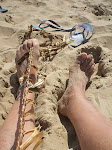
Monday was a special day because some tools and materials, equipment and the piece I am working on were moved into my new studio. Never having had the luxury of a purpose built workspace before (I have always worked in spaces meant for other things) it was quite an emotional experience for me.
It would have been possible for me to continue working as I always have done but I wanted to have a space big enough for me to be able to offer workshops and classes in the same space that I work in. I have always taught wherever I have been asked to teach but recently I have realised that the space in which you teach is almost as important as what and how you teach. Not only because the students can learn more about material storage and preparation, tool organisation and working methodology but also because the makers/artists philosophy is evident in the environment they have created to work in and the students can see their own work in the same sympathetic context. Trying to teach willow basket making in a classroom full of computers is not only a logistical nightmare but it makes it very difficult for the students to see and appreciate what they have achieved.

There are some lovely places to teach that are no ones' private studio or workshop, El Taller in Lugo, Galicia is a superb dedicated basket learning centre (that is sadly currently being threatened by administrative changes).

Sellafirth Hall on Yell in Shetland is a tin shed but with a lovely wooden interior and atmosphere that just seems ideal for basket making and under the trees in a village square in Mas de Barberans, Tarragona is also a very special place to teach and learn in, as some lucky people will discover this coming weekend http://www.cdrmuseudelapauma.cat/activitats.html
We started building these studios just under 3 years ago and although there is still work to do, it is now possible to work and teach in my space, all I need now are some students, some door handles and to clean the windows.
Thanks go to Yvette Clergeau ( Madame Le Maire) and Ghislaine (her secretary) for their assistance with the plans, to Lionel Belair for the walls and floor and Neil Read for the roof and electrics both of these men were super professional and a pleasure to give our savings to www.charenterenovation.com Thanks also to Pascal Carr for sharing his knowledge of stonework and John Guest and Mick Miller for help with plaster boarding at great heights, something I was unable to assist with. But most of my appreciation has to go to JJ who has worked solidly, often on his own in heat-waves and bitter cold, in dust and at 5 metres high on a ladder to give me a space of my own to work in, I cannot thank him enough.




 It struck me then how important these demonstrations are in terms of teaching the general public about the quantity and quality of the work that goes into making a basket. Those that had watched this man would have had no doubt that it was worth every cent of the 31€ he was asking for it.
It struck me then how important these demonstrations are in terms of teaching the general public about the quantity and quality of the work that goes into making a basket. Those that had watched this man would have had no doubt that it was worth every cent of the 31€ he was asking for it.



